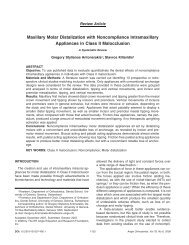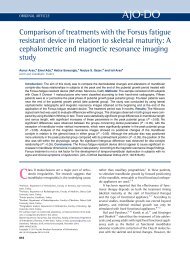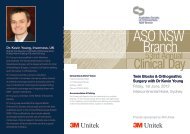As
Efficiency of a skeletonized distal jet appliance supported by ...
Efficiency of a skeletonized distal jet appliance supported by ...
You also want an ePaper? Increase the reach of your titles
YUMPU automatically turns print PDFs into web optimized ePapers that Google loves.
582 Kinzinger et al American Journal of Orthodontics and Dentofacial Orthopedics<br />
October 2009<br />
Table I. Changes in permanent first molar position induced by distal jet therapy in the horizontal plane<br />
Cast analysis n T1 mean T1 SD T2 mean T2 SD DT1-T2 mean DT1-T2 SD Significance<br />
UR2 distal-UR6 mesial (mm) 10 20.80 2.04 24.81 2.34 –4.01 0.63<br />
UL2 distal-UL6 mesial (mm) 10 21.17 1.90 24.81 2.08 –3.64 0.69<br />
‡<br />
Mesiobuccal cusp tips UR6-UL6 (mm) 10 50.80 2.16 52.59 1.28 –1.79 1.08<br />
†<br />
Central fossa UR6-UL6 (mm) 10 45.80 2.36 48.39 2.04 –2.58 0.69<br />
‡<br />
Distobuccal cusp tips UR6-UL6 (mm) 10 53.06 1.70 56.09 1.49 –3.03 0.68<br />
‡<br />
Tooth UR6 rotation ( ) 10 12.86 6.15 21.21 6.28 –8.35 7.66 *<br />
Tooth UL6 rotation ( ) 10 13.43 4.29 18.93 5.94 –7.88 5.50 *<br />
Determination of type of molar rotation: angle between midpalatal raphe and a line running through the mesiobuccal and distobuccal cusps of the<br />
molars; for DT1-T2 (value before distalization) – (value after distalization): positive value 5 mesiobuccal and distopalatal rotation, negative value 5<br />
mesiopalatal or distobuccal rotation.<br />
*P \0.05; † P \0.01; ‡ P \0.001.<br />
‡<br />
Table II. Skeletal angular and linear measurements<br />
Cephalometric analysis n T1 mean T1 SD T2 mean T2 SD D T1-T2 mean D T1-T2 SD Significance<br />
Skeletal-angular<br />
SNA ( ) 10 83.55 2.63 83.36 2.78 0.19 0.80 NS<br />
SNB ( ) 10 79.83 3.42 79.70 3.27 0.13 0.83 NS<br />
S-N/ANS-PNS ( ) 10 5.56 1.92 5.18 1.53 0.38 1.18 NS<br />
ANS-PNS/Go-Me ( ) 10 24.20 4.31 25.08 4.14 –0.88 1.09 NS<br />
Björk’s summation angle ( ) 10 389.61 3.29 390.34 3.49 –0.73 1.26 NS<br />
Skeletal-linear<br />
S-Go:N-Me (%) 10 67.49 2.79 66.91 2.60 0.58 1.51 NS<br />
NS, Not significant.<br />
In the area of the CEJ, the permanent first molars<br />
were distalized by a mean of 3.92 6 0.53 mm and intruded<br />
by a mean of 0.16 6 0.26 mm. At the same<br />
time, they experienced distal tipping of 2.79 6 2.51 <br />
in relation to the palatal plane and 3.00 6 2.31 in relation<br />
to the anterior cranial base. The second premolars,<br />
which were not part of the anchorage setup, drifted distally<br />
after the molars by 1.87 6 0.74 mm, elongating by<br />
0.42 6 0.41 mm and tipping, in relation to the respective<br />
reference planes, by 3.00 6 2.69 and 3.21 6 2.86 .<br />
The first premolars, included in the anchorage setup,<br />
mesialized by 0.72 6 0.78 mm, extruded by 0.14 6 0.14<br />
mm, and, at the same time, tipped by 1.15 6 2.98 in<br />
relation to the palatal plane and by 0.79 6 2.23 in relation<br />
to the anterior cranial base. The central incisors<br />
were protruded by 0.36 6 0.32 mm and extruded by<br />
0.14 6 0.29 mm, and showed slight labial tipping<br />
of 0.57 6 0.79 in relation to the palatal plane and<br />
0.64 6 0.75 to the anterior cranial base.<br />
All linear dental movements in relation to the pterygoid<br />
vertical, the extrusion of the premolars, and the<br />
angular dental position changes of the second premolars<br />
and first molars were significant (Table III).<br />
The total movement in the sagittal plane was 4.28 6<br />
0.51 mm (cumulating molar distalization and central incisor<br />
protrusion) or 4.64 6 1.06 mm (cumulating molar<br />
distalization and first premolar mesialization). Based on<br />
the values obtained for the permanent first molars—<br />
distalization length of a mean 3.92 6 0.53 mm—molar<br />
distalization represents 91.71% 6 7.32% and 86.56%<br />
6 13.21%, respectively, of the total sagittal movement<br />
(Table IV).<br />
DISCUSSION<br />
The outcomes confirm the efficiency of the distal jet<br />
in clinical applications. Cast registrations showed that<br />
the supporting zone had increased, and that a therapeutically<br />
desired widening of the dental arch, as well as mesial<br />
inward and distal outward rotations of the molars,<br />
had occurred. The biomechanical explanation of this effect<br />
is that force is applied palatally from the center of<br />
resistance of the molars. In theory, a toe-in bend would<br />
be appropriate to compensate for this effect, but it results<br />
in friction in the guide tubes of the appliance.<br />
This effect was verified with the casts used and by an<br />
in-vitro registration. The resultant adhesive effect expressing<br />
this friction reduced the distalization force substantially<br />
and, accordingly, would be an obstacle for<br />
distalization of the molars. Therefore, a toe-in bend<br />
should not be used, although it would be therapeutically<br />
desirable. 4 After the distal jet treatment, the molars






